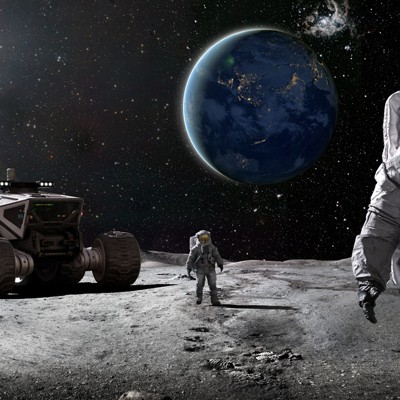When I was growing up, there was nothing more exciting than getting a fresh new set of wheels. Whether it was a new bike or even a shiny new remote-control car, those chariots were always the key to grand new adventures. NASA, it seems, feels the same way, but on a much bigger scale.
The agency is once again calling on citizen innovators to help design the future, this time through a new HeroX challenge to develop better wheels and more robust tires for lunar rovers. The competition, called the Rock and Roll with NASA Challenge, offers $155,000 in prizes for top designs that can handle the punishing surface of the moon. As with previous NASA and HeroX challenges, everyone from amateur inventors working out of their garages to teams of students or professional companies are welcome to participate.
For those who have followed NASA’s crowdsourcing work, this is familiar territory. Through the NASA Tournament Lab and its long-running collaboration with HeroX, the agency has tapped public creativity to solve all kinds of problems — everything from improving astronaut gloves to developing virtual reality training tools for spacewalks and Mars missions. In fact, I even entered a Nextgov/FCW team into one of those earlier HeroX competitions, the MarsXR Challenge, a few years back. The goal then was to design VR training environments that could prepare astronauts for life on Mars. My team earned an honorable mention during the first phase, and the process gave me a real appreciation for how seriously NASA takes these open innovation programs. And the winners of that challenge did some highly impressive work.
The new Rock and Roll with NASA Challenge builds on that same idea. The agency is hoping to get some fresh thinking from outside their traditional engineering teams. But this time, the focus is on something that seems deceptively simple: tires.
On Earth, tires face friction, wear and tear, heat and other hazards like moisture and temperature fluctuations. But on the moon, those challenges are exaggerated in almost unimaginable ways. For example, lunar dust is sharp and clingy, temperatures swing hundreds of degrees between night and day, and there’s no atmosphere to help dissipate heat or cushion impacts. Conventional rubber tires would crack and fail almost as soon as they hit the road. That’s why NASA is looking for new materials and designs that are flexible, lightweight and durable enough to survive repeated trips across the lunar surface.
In fact, the lunar surface makes for one of the harshest road trips ever conceived. The challenge overview makes this painfully clear: temperatures on the moon swing from roughly 250 degrees Fahrenheit in sunlit equatorial zones to as low as negative 427 degrees in permanently shadowed craters. Even the soil works to destroy tires on the moon. Called regolith, it contains jagged fragments that are far more abrasive than Earth’s sand. It clings to surfaces, creeps into joints and grinds away metals from the inside out. So, those new tires better be ready for some extreme conditions.
The gravity difference on the moon adds another challenge. While it may sound like having one sixth the gravity of Earth might give tires a bit of a break up there, in many cases the opposite is true. That’s because the light gravity means that rovers on the moon tend to lose traction since they are not being pressed as hard against the surface. They also tend to fly up when traveling at high speeds over bumpy terrain. While the image of a mars rover jumping Dukes of Hazzard style over lunar dunes is pretty cool, when that rover lands, it’s the tires that will take the brunt of the impact.
As with previous challenges, this one is being conducted in three stages. The first is the proof of concept phase. Teams will need to submit CAD drawings of their wheel design and a white paper explaining how their tires work and what materials will be used in their construction. In phase two, teams will be tasked with building a prototype of their design. And finally, in the last phase, the wheels will be fitted onto a MicroChariot Rover and driven through the Rock Yard testing facility at NASA’s Johnson Space Center in Houston, Texas. The road test will simulate conditions on the moon as much as possible to really put the prototype wheels to the ultimate test.
The challenge also fits neatly into NASA’s broader goals for the Artemis program, which aims to establish a sustainable human presence on the moon as a steppingstone to Mars. The rovers and equipment that support those missions need to last longer and perform better than anything used during the Apollo program. NASA would like the newly designed tires to run for over 1,000 kilometers or more without maintenance.
For those who want to get involved, submissions for the Rock and Roll Challenge are open through November, with winners to be announced early next year. So, if you’ve ever wanted to help NASA kick the tires on a new vehicle, this is your chance. Just be ready for a test drive like no other, where the road really is out of this world.
John Breeden II is an award-winning journalist and reviewer with over 20 years of experience covering technology. He is the CEO of the Tech Writers Bureau, a group that creates technological thought leadership content for organizations of all sizes. Twitter: @LabGuys

